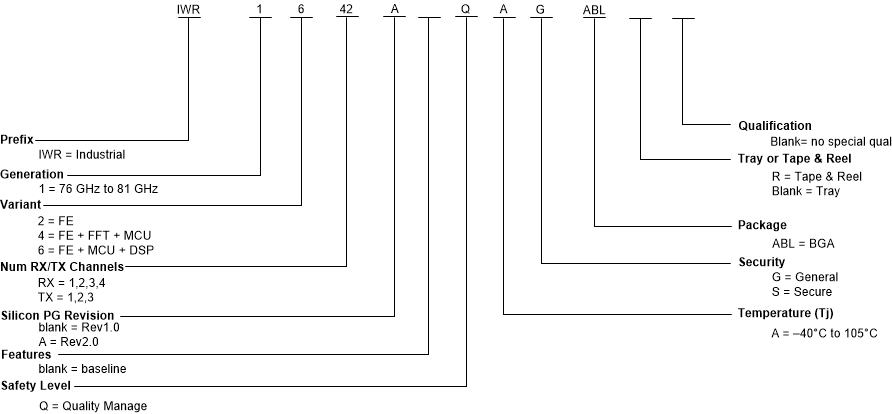JAJSE44B May 2017 – April 2018 IWR1642
PRODUCTION DATA.
- 1 デバイスの概要
- 2 改訂履歴
- 3 Device Comparison
- 4 Terminal Configuration and Functions
-
5 Specifications
- 5.1 Absolute Maximum Ratings
- 5.2 ESD Ratings
- 5.3 Power-On Hours (POH)
- 5.4 Recommended Operating Conditions
- 5.5 Power Supply Specifications
- 5.6 Power Consumption Summary
- 5.7 RF Specification
- 5.8 CPU Specifications
- 5.9 Thermal Resistance Characteristics for FCBGA Package [ABL0161]
- 5.10
Timing and Switching Characteristics
- 5.10.1 Power Supply Sequencing and Reset Timing
- 5.10.2 Input Clocks and Oscillators
- 5.10.3
Multibuffered / Standard Serial Peripheral Interface (MibSPI)
- 5.10.3.1 Peripheral Description
- 5.10.3.2
MibSPI Transmit and Receive RAM Organization
- Table 5-7 SPI Timing Conditions
- Table 5-8 SPI Master Mode Switching Parameters (CLOCK PHASE = 0, SPICLK = output, SPISIMO = output, and SPISOMI = input)
- Table 5-9 SPI Master Mode Input Timing Requirements (CLOCK PHASE = 0, SPICLK = output, SPISIMO = output, and SPISOMI = input)
- Table 5-10 SPI Master Mode Switching Parameters (CLOCK PHASE = 1, SPICLK = output, SPISIMO = output, and SPISOMI = input)
- Table 5-11 SPI Master Mode Input Requirements (CLOCK PHASE = 1, SPICLK = output, SPISIMO = output, and SPISOMI = input)
- 5.10.3.3 SPI Slave Mode I/O Timings
- 5.10.3.4 Typical Interface Protocol Diagram (Slave Mode)
- 5.10.4 LVDS Interface Configuration
- 5.10.5 General-Purpose Input/Output
- 5.10.6 Controller Area Network Interface (DCAN)
- 5.10.7 Serial Communication Interface (SCI)
- 5.10.8 Inter-Integrated Circuit Interface (I2C)
- 5.10.9 Quad Serial Peripheral Interface (QSPI)
- 5.10.10 ETM Trace Interface
- 5.10.11 Data Modification Module (DMM)
- 5.10.12 JTAG Interface
- 6 Detailed Description
- 7 Monitoring and Diagnostics
- 8 Applications, Implementation, and Layout
- 9 Device and Documentation Support
- 10Mechanical, Packaging, and Orderable Information
9.1 Device Nomenclature
To designate the stages in the product development cycle, TI assigns prefixes to the part numbers of all microprocessors (MPUs) and support tools. Each device has one of three prefixes: X, P, or null (no prefix) (for example, IWR1642). Texas Instruments recommends two of three possible prefix designators for its support tools: TMDX and TMDS. These prefixes represent evolutionary stages of product development from engineering prototypes (TMDX) through fully qualified production devices and tools (TMDS).
Device development evolutionary flow:
- XExperimental device that is not necessarily representative of the final device's electrical specifications and may not use production assembly flow.
- PPrototype device that is not necessarily the final silicon die and may not necessarily meet final electrical specifications.
- nullProduction version of the silicon die that is fully qualified.
Support tool development evolutionary flow:
- TMDXDevelopment-support product that has not yet completed Texas Instruments internal qualification testing.
- TMDSFully-qualified development-support product.
X and P devices and TMDX development-support tools are shipped against the following disclaimer:
"Developmental product is intended for internal evaluation purposes."
Production devices and TMDS development-support tools have been characterized fully, and the quality and reliability of the device have been demonstrated fully. TI's standard warranty applies.
Predictions show that prototype devices (X or P) have a greater failure rate than the standard production devices. Texas Instruments recommends that these devices not be used in any production system because their expected end-use failure rate still is undefined. Only qualified production devices are to be used.
TI device nomenclature also includes a suffix with the device family name. This suffix indicates the package type (for example, ABL0161), the temperature range (for example, blank is the default commercial temperature range). Figure 9-1 provides a legend for reading the complete device name for any IWR1642 device.
For orderable part numbers of IWR1642 devices in the ABL0161 package types, see the Package Option Addendum of this document, the TI website (www.ti.com), or contact your TI sales representative.
For additional description of the device nomenclature markings on the die, see the IWR1642 Device Errata.
